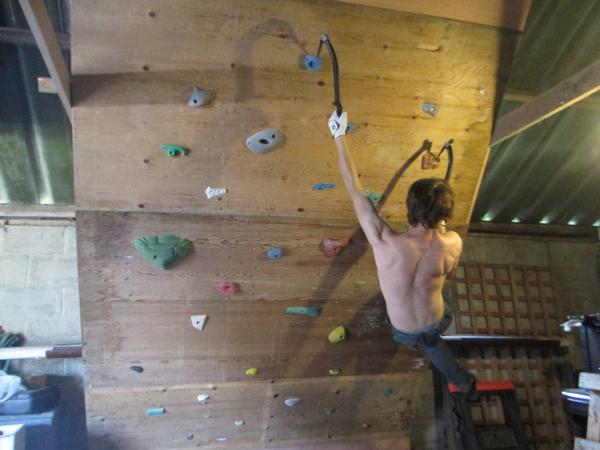This saturday saw the first round of the 2014 British Tooling Series at Beacon Climbing Center in North Wales. The British Tooling Series has evolved from the popular Scottish Tooling Series, which has been running north of the border for a few years already.
The Beacon put on a great show, with additional excitement thanks to it also being their 20th birthday weekend. Happy Birthday Beacon! The day saw, in addition to the tooling comp, a fun boulder comp, a talk my Tim Emmett and Will Gadd and an Indian meal.
The dry tooling competition took place on 8 qualification routes. These were a combination of routes using Alpkit figfours and normal axes and had something for all abilities.
 |
| Qualifying |
There was a good turn out on the day with some old STS faces as well people new to tooling and others that are just starting out in competitions.
After all the competitors had tested themselves on the qualifying routes it was time for the finals. There were two finals routes, one for the female finalists and one for the males. Both of these looked thin and sketchy and generally pretty hard, but what else would you expect being set by the master of sketchy climbing himself, Nick Bullock.
The female finalists were Anna Wells, Katy Forrester and Megan Beaumont, while the male finalists were Tim Mueller, Will Woodhead, Matt Pigden, Dave Bowes, Scott G and myself. I was second to last out so I didn't watch any of the female finals, however the competition was won by dry tooling guru Anna Wells. I didn't see much of the mens finals for the same reason either, so we join it at my attempt.
Walking out of isolation I didn't know how everyone had done, so I just had to do as well as I could. There was no time limit for the final, it was just who got furthest, which suited my slow style of climbing. I made very slow progress up to the last hold on the route, which I ended up ripping off while getting into a position to clip the lower off. Scott was last up and climbed the route with ease, but got the rope caught around a hanging pipe, causing terrible rope drag. This eventually caused made him to fall off. If it wasn't for this I'm sure he'd have won, but it in the end my attempt was just good enough to win it. DMM very generously donated a rope for each of the winners.
The British dry tooling scene is a really cool thing to be involved in at the moment with loads of psyched climbers. Its shaping up to be a really good series and started in fine style at Beacon Climbing Centre. Get involved!
Despite being really tired from the comp on saturday I was not done with competing for the weekend. Sunday was the British Fell Relays, held on Middleton Fell, just north of Kirby Lonsdale. I was running as part of York Knavesmire Harriers A team. The other team members were Neil Stabbs, Chris Roberts, Giles Hawking, Tom Ratcliffe and Simon Collins.
 |
| Mass start for leg 1 |
The race was in 4 legs. 2 short legs, run first and last, a long leg run second and a navigation leg run third. I was on the final short 10k leg.
The race started at 10am, and about 3 hours later it was finally my turn to run. The rest of the team had put me in a good position, although we were never in contention to win we could achieve a respectable position.
 |
| Knavesmire (yellow and black) at the end of leg 2 |
The weather wasn't great for my run with strong winds, low cloud and rain on the tops of the hills. Despite this I tried my best and brought Knavesmire home in a respectable 57th place, running my leg as the 50th fastest.
It was all together a good weekend, although I was very tired on monday morning!
There are a distinct lack of photos for the amount of text, but I was busy doing things.

























































